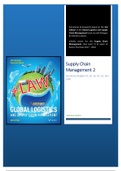Samenvatting
Summary Supply Chain Management p2 - Chapters 9, 10, 13, 14, 15, 18
- Instelling
- Saxion Hogeschool (Saxion)
Summaries & Keywords based on the 3rd edition of the Global Logistics and Supply Chain Management book, by John Mangan & Chandra Lalwani. Initially meant for the Supply Chain Management class (part 2, including the Law aspect) & exam of Saxion Enschede 2017 – 2018
[Meer zien]





